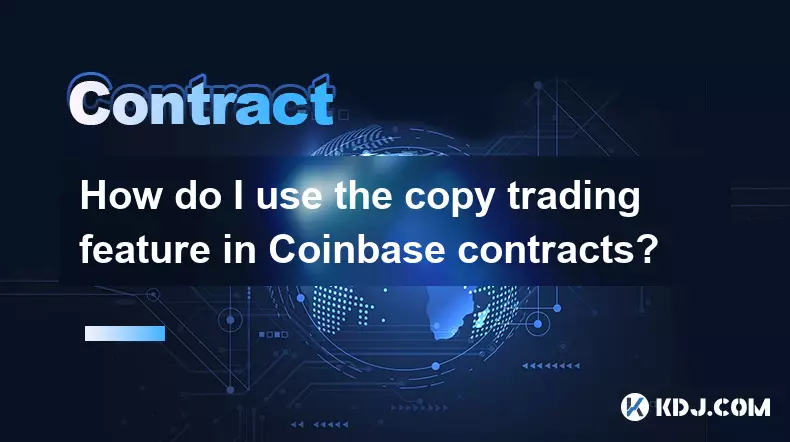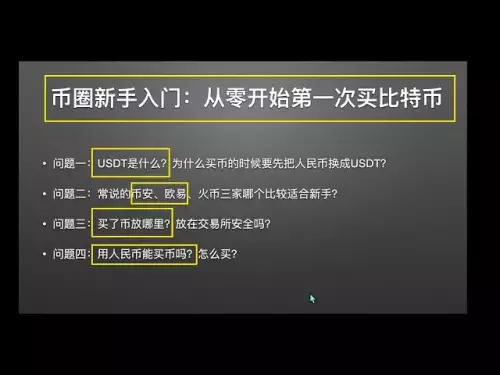-
 bitcoin
bitcoin $113137.862908 USD
0.65% -
 ethereum
ethereum $4107.436072 USD
-1.96% -
 xrp
xrp $2.908808 USD
2.59% -
 tether
tether $1.000294 USD
0.01% -
 bnb
bnb $1010.914842 USD
-1.12% -
 solana
solana $210.653310 USD
-2.16% -
 usd-coin
usd-coin $0.999776 USD
-0.01% -
 dogecoin
dogecoin $0.239360 USD
-0.04% -
 tron
tron $0.337849 USD
0.37% -
 cardano
cardano $0.807698 USD
-0.61% -
 hyperliquid
hyperliquid $45.387447 USD
0.61% -
 chainlink
chainlink $21.408287 USD
-0.92% -
 ethena-usde
ethena-usde $1.000509 USD
-0.04% -
 avalanche
avalanche $32.634682 USD
-4.77% -
 sui
sui $3.349772 USD
-0.19%
How do I use the copy trading feature in Coinbase contracts?
Coinbase doesn't offer copy trading due to regulatory and risk concerns, so users must manually mimic trades or use third-party platforms like eToro or Bybit.
Sep 19, 2025 at 09:19 pm

Understanding Copy Trading in the Context of Coinbase
1. Coinbase does not currently offer a copy trading feature within its contracts or any other product segment. The platform primarily focuses on spot trading, staking, and limited derivatives through Coinbase Advanced Trade. Users interested in replicating trades of experienced traders must rely on third-party tools or alternative exchanges that support such functionality.
2. While Coinbase provides an intuitive interface for buying and selling cryptocurrencies, it lacks social trading mechanisms. This means users cannot automatically mirror the positions or strategies of other traders directly on the platform. Any attempt to simulate copy trading would require manual execution based on external signals or analysis.
3. The absence of built-in copy trading reflects Coinbase’s regulatory-focused approach. By limiting advanced features like automated strategy replication, the exchange maintains compliance with U.S. financial regulations, especially those concerning investor protection and unsolicited advice.
4. Traders seeking automated portfolio mirroring should consider platforms specifically designed for social or copy trading, such as eToro, Binance Futures, or Bybit. These services allow users to allocate funds toward following top-performing traders, often with transparent performance metrics and risk disclosures.
5. Despite not supporting copy trading, Coinbase remains a trusted gateway for new entrants into the crypto space due to its strong security protocols, insurance coverage, and educational resources. Its ecosystem prioritizes simplicity and safety over complex, behavior-driven trading models.
Why Copy Trading Is Not Available on Coinbase Contracts
1. Regulatory constraints play a major role in the exclusion of copy trading from Coinbase’s offerings. Financial authorities closely monitor platforms where one user’s actions directly influence another’s transactions, particularly when profits are shared or incentivized.
2. Coinbase operates under strict licensing requirements in multiple jurisdictions, particularly the United States. Introducing a feature that enables automatic trade replication could classify certain users as unregistered investment advisors, triggering legal complications.
3. Risk management is another critical factor. Automated copying of leveraged positions—especially in volatile markets—can lead to rapid losses. Coinbase avoids facilitating high-risk behaviors that may result in customer disputes or reputational damage.
4. The technical infrastructure required for real-time signal synchronization, performance tracking, and follower incentive structures is complex. Coinbase has chosen to invest in core functionalities like wallet integration, tax reporting, and institutional-grade custody instead.
5. Even though futures and perpetual contracts are available via Coinbase Advanced Trade, these instruments are presented as self-directed tools. There is no mechanism for linking accounts or broadcasting trade decisions across user profiles.
Alternatives to Achieve Similar Outcomes
1. Some traders use external analytics dashboards like Nansen, DexScreener, or Arkham Intelligence to track large wallets and emulate their moves manually on Coinbase. This method requires discipline but offers transparency into whale activity.
2. Signal groups on Telegram or Discord often share entry and exit points for specific assets. Users can subscribe to these channels and execute corresponding trades on Coinbase, effectively creating a semi-automated form of copy trading.
3. Third-party bots integrated with Coinbase’s API can be programmed to react to price changes or indicators. While not true copy trading, these bots can follow predefined rules inspired by successful trader strategies.
4. Multi-platform traders might hold primary positions on exchanges with native copy trading (e.g., Bybit), while using Coinbase mainly for secure asset storage or fiat on-ramps. This hybrid model balances convenience and functionality.
5. Portfolio tracking tools like Delta or CoinGecko allow users to benchmark their performance against market leaders. Though passive, this comparison helps refine personal strategies over time without direct replication.
Frequently Asked Questions
Q: Does Coinbase Advanced Trade support API-based automation?A: Yes, Coinbase Advanced Trade supports REST and WebSocket APIs, allowing developers to build custom trading bots. However, these must be self-coded or configured through third-party bot platforms.
Q: Are there plans for Coinbase to introduce social trading features?A: As of now, Coinbase has not announced any roadmap items related to social or copy trading. Company communications emphasize compliance, education, and institutional adoption over retail-focused behavioral tools.
Q: Can I lose more than my initial investment when trading contracts on Coinbase?A: No. On Coinbase Advanced Trade, all derivative positions are subject to full collateralization. Users cannot incur debt or exceed their account balance, eliminating the risk of negative equity.
Q: How do margin requirements work on Coinbase contracts?A: Coinbase uses isolated margin by default. Each position is backed by a dedicated amount of collateral, which limits potential losses to the allocated funds for that specific trade.
Disclaimer:info@kdj.com
The information provided is not trading advice. kdj.com does not assume any responsibility for any investments made based on the information provided in this article. Cryptocurrencies are highly volatile and it is highly recommended that you invest with caution after thorough research!
If you believe that the content used on this website infringes your copyright, please contact us immediately (info@kdj.com) and we will delete it promptly.
- Flare Ignites XRP DeFi with FXRP: A New Era for XRP?
- 2025-09-25 16:45:15
- Naver, Dunamu, and Stablecoins: A Korean Fintech Tango
- 2025-09-25 16:25:13
- Beacon Speedrun Bonanza: RON Prizes and Contest Kickoff!
- 2025-09-25 16:25:13
- BASE HYPE: Net Flows Signal a Shift in Investor Interest
- 2025-09-25 16:45:15
- Senator Warren, AI, and USD1 Stablecoin: Unpacking the Connections
- 2025-09-25 16:50:01
- Ragasa's Ripple Effect: How a Typhoon Exposed iPhone Production Vulnerabilities
- 2025-09-25 16:30:01
Related knowledge

How do I enable the "scalping-only" mode for Cardano (ADA) contracts?
Sep 24,2025 at 03:19am
Understanding Scalping Strategies in Crypto Derivatives1. Scalping in cryptocurrency trading refers to executing multiple short-term trades within min...

What is the maximum position limit for Cardano (ADA) contracts?
Sep 23,2025 at 11:00pm
Understanding ADA Futures and Derivatives Market Structure1. Cardano (ADA) futures contracts are offered by several major cryptocurrency derivatives e...

How can I view open interest in Cardano (ADA) contracts?
Sep 24,2025 at 07:36am
Understanding Open Interest in Cardano Derivatives1. Open interest refers to the total number of outstanding derivative contracts, such as futures or ...

What is the function of the insurance fund in Cardano (ADA) contracts?
Sep 24,2025 at 02:18am
Understanding the Role of Insurance Funds in Cardano Smart Contracts1. The insurance fund within Cardano's ecosystem is not a native feature directly ...

How can I view historical transaction records for Cardano (ADA) contracts?
Sep 24,2025 at 04:01pm
Understanding Cardano's On-Chain Data Structure1. Cardano operates on a proof-of-stake blockchain that records all transactions in blocks secured thro...

How is the funding rate charged for Cardano (ADA) contracts?
Sep 24,2025 at 07:19am
Funding Rate Mechanism for Cardano (ADA) Perpetual Contracts1. The funding rate in Cardano perpetual contracts serves as a mechanism to align the pric...

How do I enable the "scalping-only" mode for Cardano (ADA) contracts?
Sep 24,2025 at 03:19am
Understanding Scalping Strategies in Crypto Derivatives1. Scalping in cryptocurrency trading refers to executing multiple short-term trades within min...

What is the maximum position limit for Cardano (ADA) contracts?
Sep 23,2025 at 11:00pm
Understanding ADA Futures and Derivatives Market Structure1. Cardano (ADA) futures contracts are offered by several major cryptocurrency derivatives e...

How can I view open interest in Cardano (ADA) contracts?
Sep 24,2025 at 07:36am
Understanding Open Interest in Cardano Derivatives1. Open interest refers to the total number of outstanding derivative contracts, such as futures or ...

What is the function of the insurance fund in Cardano (ADA) contracts?
Sep 24,2025 at 02:18am
Understanding the Role of Insurance Funds in Cardano Smart Contracts1. The insurance fund within Cardano's ecosystem is not a native feature directly ...

How can I view historical transaction records for Cardano (ADA) contracts?
Sep 24,2025 at 04:01pm
Understanding Cardano's On-Chain Data Structure1. Cardano operates on a proof-of-stake blockchain that records all transactions in blocks secured thro...

How is the funding rate charged for Cardano (ADA) contracts?
Sep 24,2025 at 07:19am
Funding Rate Mechanism for Cardano (ADA) Perpetual Contracts1. The funding rate in Cardano perpetual contracts serves as a mechanism to align the pric...
See all articles










































































